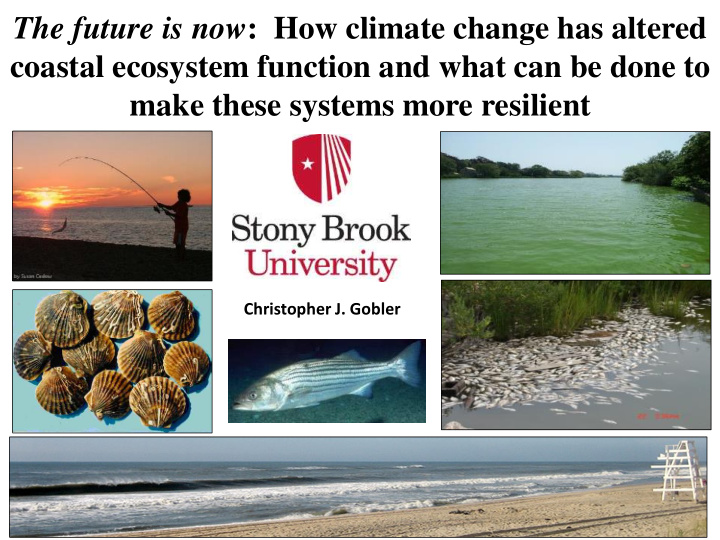



The future is now : How climate change has altered coastal ecosystem function and what can be done to make these systems more resilient Christopher J. Gobler
Projected 21 st century temperature trends
Ocean acidification Addition of acid Loss of carbonate
Ocean acidification Caldeira and Wickett 2003
, Stanford University
The future (2070) (2030) Stippling highlights watersheds with a robust change in total nitrogen flux
The future is now…
Calcifying organisms vulnerable to ocean acidification (Orr et al 2005; Doney et al 2009; Reise et al 2009; Talmage and Gobler 2009, 2010, 2011, 2012)
Top 10 fisheries in NYS, 2017, NMFS data The success of NY’s fisheries depends on bivalve shellfish. As filter feeders, bivalves rely directly on phytoplankton for food. 14,000,000 12,000,000 10,000,000 8,000,000 Dollars 6,000,000 4,000,000 2,000,000 0
Early life stage bivalves Abraham and Dillon 1986
80 Bay scallop Hard clam Percent survival 60 40 20 0 250 390 750 1500 CO2 (ppm)
Bay scallops Hard clam Low CO 2 High CO 2 Talmage and Gobler, 2010
Landings of bivalves in NY NY bay scallop landings 800,000 Hard Clam landings from Great South Bay 700,000 in bushels 600,000 500,000 400,000 300,000 200,000 100,000 0 1970 1972 1974 1976 1978 1980 1982 1984 1986 1988 1990 1992 1994 1996 1998 2000 2002 2004 2006
The future is now…
Chan anges i in global al ocean an t temperatures, , 1982-20 2012 12 Baumann and Doherty, 2013, PLoS One
35-year tr trend, s , summer w water temperature a aroun und Long I Island nd 23.5 23 June, July, August mean temperature 22.5 22 21.5 21 20.5 20 19.5 19 1980 1990 2000 2010 2020
Samples for eelgrass genetic analyses Harmful algal blooms across Long Island Brown tide PSP Seaweeds Rust Tide Toxic blue green algae DSP
Global PSP expansion of HABs In the past 40 years, the public health, recreational, tourism, fishery, aquaculture, and PSP ecosystem impacts of HABs have increased.
PSP Why have HABs expanded? • More comprehensive monitoring and assessment • Anthropogenic transport PSP • Anthropogenic nutrient loading • Climate change
Dinoph physis a acumina nata and diarr rrhetic sh shellf llfis ish poisoning ( g (DSP) Okadaic acid
Global distribution of DSP, ~2010
Dinophysis a acumi minata , N , Nort orth Atla tlantic t ic trend, 1 , 1982 - 2016 16 Trend in bloom season, days per year Trend in mean growth rate Gobler et al., 2017, PNAS
Dinophysis a acumi minata , N Northeast U US trend, 1 1982 82 - 2016 16 2015 2000 2011 Gobler et al., 2017, PNAS
Dinophysis acuminata , North Pacific, trend in bloom season Days per yr Gobler et al., 2017, PNAS
Global DSP, recent North American expansion Post- 1982 Post-2011 Post- 2000
Alexandrium red tides and paralytic shellfish poisoning (PSP) on Long Island Saxitoxin Alexandrium
Alexandrium trend i nd in n bl bloom sea eason a n and nd growth rate, N , Nor orth th Atlanti tic, 198 , 1982 - 2016 016 Trend in bloom season, days per year Trend in mean growth rate Gobler et al., 2017, PNAS
Alexandr ndrium um trend i in b bloom season N North P Pacific Days per yr Gobler et al., 2017, PNAS
Glob obal al P PSP e even ents Gobler et al., 2017, PNAS
, Stanford University
Nutrient Decay of algae = Nutrients stimulate discharge into ↑CO 2 , ↓ pH, ↓ DO algal blooms coastal zone
Long Island Sound, August 2012 Western half: • Dissolved oxygen < 4 mg L -1 • pH < 7.4 (total scale) • pCO2> 2,000 ppm • Ω aragonite < 1 • What are the seasonal patterns of dissolved oxygen and pH? • CTDEP record 2010-2012 Wallace et al, 2014, ECCS NYC
Excessive nutrient loading exacerbates acidification and many HABs. Mitigating excessive nutrient loading to coastal zones will make them more resilient to impending climate change.
Conclusions: • Ocean acidification since the Industrial Revolution has contributed to the declines in the populations of calcifying bivalves. • For multiple regions of the North Atlantic and some regions of the North Pacific ocean warming has expanded the potential niche of PSP and DSP causing HABs since 1982. • Excessive nutrient loading can and will synergistically intensify ocean acidification and HABs. • Mitigating nutrient loading can promote resilence against climate change
Thank you for your attention
Recommend
More recommend